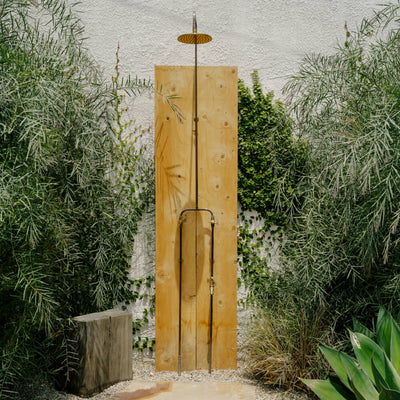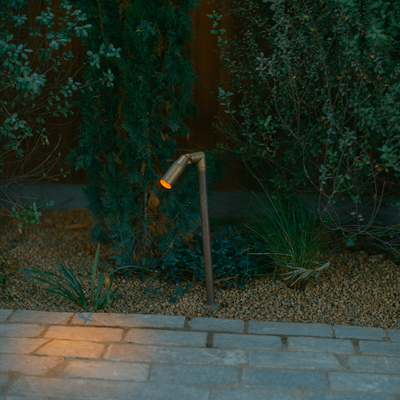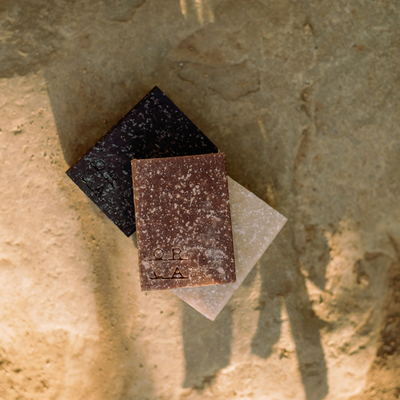PLANTS +
PEOPLE
A study of the symbiotic relationship between
humans and the gardens they tend to.
At OR.CA, our work begins by understanding that it doesn’t end — a landscape is an ongoing dialogue, shaped by seasons and in response to our environments. Plants + People is an ongoing exploration of what it looks like to plant roots, to honor cycles, to inhabit space, and to accept impermanence through the perspectives of individuals we admire.
jorge gaviria
008 jorge gaviria
region: central valleys of oaxaca
plant community: coastal sage scrub
photography: molly decoudreaux c/o masidenda

The story of corn is inherently tied to people — part of a category of plants called cultigens, the plant cannot survive without human intervention. Corn's origins have been traced to the Balsas River Valley in south-central Mexico about 9,000 years ago. As people cultivated corn there, so too did the plant nourish them. So deeply ingrained was the connection between corn and people that many early Mesoamerican civilizations believed that humans were born from the ears of the corn plant. The botanical name for the species used to this day is Zea mays — "Zea" meaning "wheat-like grain," and "mays" from the Taino word meaning "giver of life."
Jorge Gaviria is the founder of Masienda, a brand of heirloom corn dedicated to reconnecting people to the staple crop through its cultural significance, culinary versatility and distinctive flavors. Working with a broad network of small-scale farmers in Mexico who prioritize genetic diversity and regenerative farming practices, Masienda's masa (or corn dough), invites professional chefs and home cooks alike to experience tortillas made in the style of Oaxaca's central valleys and beyond.
We spoke to Jorge about his diverse cultural upbringing in Miami, encountering "agriculture in the clouds" on the Oaxacan coast and how journeying into the world of masa has changed his relationship to food.
Can you share about the journey that led you to corn and masa?
After a stint in education in New York, I got into food and started to explore different areas of the industry from farming to restaurants. I worked in New York at Maialino, which is a Danny Meyer restaurant, and then Blue Hill. It was at that time that I was really ready to do something on my own, and in food specifically.
When I was working at Blue Hill, the conversation was dominated by nose-to-tail farming and hyper intentional sourcing. I realized that of all the foods we were sourcing and creating in the restaurant, none of them really spoke to the culture I grew up in. It was always through a French or New American lens, and I wanted to see foods I grew up eating represented in that same ethos. My goal was to launch a food business. I didn't know what it was, but I knew it had to be something that spoke to the connectedness of Latin culture.
Masa was it. Masa is corn dough that goes through this alchemical process called nixtamalization which makes it super nutritious and flavorful.
At first, I was going to open up a tortilleria in Brooklyn. I had reconnected with Enrique Olvera [owner of Mexico City's renowned Pujol restaurant], who was planning on opening a restaurant called Cosme in New York. I asked if he wanted to buy tortillas from me for his restaurant. He said "No, but if you're sourcing corn from Mexico, I'd totally buy that." One thing led to another and I started building the supply chain first in 2014. It wasn’t until 2020 that we ended up getting into more of the direct-to-consumer experience.

How was the process starting with focusing on your supply chain and then pivoting toward the consumer side?
It's fun! One of the humbling aspects of food is that it takes an enormously long time to overhaul a value chain for any staple. Agriculture doesn't respond as quickly as tech. It's an incredibly slow, methodical and deliberate process and has a lot more variables to reckon with — weather being one of them, climate change, people. So it's taken that long just to establish the supply chain we felt would be responsibly scalable. The fun part has been to figure out how to parlay that goodwill that we've earned in the restaurant industry toward consumer awareness. To connect those audiences and also continue to speak to both in ways that resonate has been a fun challenge.
We try make things as entertaining and educational as we can because most people still don't know what masa is even though all of us consume it all the time. You can ask anyone in the United States if they've had a taco in the last week and they'll probably say yes, but they don't know what the foundation of that food is.
I wrote a book called Masa [Masa: Techniques, Recipes and Reflections on a Timeless Staple (Chronicle Books)], that came out last year. Before that book existed there was nothing that was out there on the subject. It was very much an oral tradition. So if you grew up with this food and wanted to reconnect in a deeper way, or if you didn't and were just a really curious project cook, you couldn't easily jump in. There wasn't an easy guide to get you there.
Can you tell us more about some of your early memories of food or cooking?
I grew up in a diverse Hispanic community in Miami. My dad was born in Cuba and my mom was born in Mexico, but they both lived all throughout Latin America. I think the community in Miami really mirrors that experience — it's not defined by any one single Latin culture. It's really quite an eclectic identity overall. And so the food really reflected that. I grew up eating everything from ropa vieja, which was one of my favorite Cuban dishes growing up, to tostadas, arepas and carnitas.
With respect to Latin foods, I didn’t see any brands that had evolved with my own values as a consumer. No one was really talking about where their ingredients came from or how it's made, and my goal was to anchor that experience with some more context and quality. Masa was such a perfect place to do it because it's found throughout much of Latin America and it's such a defining staple of its cultures.
Can you talk more about that and how that differs from how corn is produced and consumed in the US?
We generally think of corn in the United States mostly as Frankenfood — certainly not something that's culturally significant or meaningful.
Unlike in the US, where most farmers are growing to sell, most corn farmers in Mexico are subsistence growers, meaning they are growing food for their own consumption. These folks have been passing down seeds in their families for hundreds or thousands of years:heirloom species that are locally adapted, also known as landraces. They can only really thrive in the areas that have birthed them.
So how do you work within that system when this is really food that's intended for someone's home? We work within a surplus model, so we only purchase what's in excess of what the family or community determines it needs or wants. That presented the first challenge — it meant that we've had to scale through the volume of folks rather than the individual farmer. We started our first year with about 12 farmers and today we work in a network of about 2,000. Each of those growers manages a five- to 10-acre plot that they maintain at any given time with their families — it's basically micro agriculture.
Olotillo
Farmers prize the Olotillo landrace of corn for its resilience in poor or unfertilized soils. It's considered the most important maize race in the ecoregion between the Chiapas Highlands and Sierra Madre de Chiapas in Mexico, but it is also common in other regions around the country. Olotillo variants include blanco, amarillo, or rojo, based on the color of the cob's kernels.

Marigold
(Tagetes)
Marigolds are native to Mexico and are used to decorate altars during Day of the Dead celebrations around the world. Members of the Marigold family are heat-loving and should be planted in full sun. These fast-growing plants achieve blooming maturity within a few months when planted from seeds.

Take us on a sensory journey of some of Masienda's partner farms and describe how they smell, look or sound.
The first experiences I had with this type of agriculture were in Oaxaca. What's amazing about Oaxaca is that it's got somewhere around 4% of the country's total landshare and yet it has more biodiversity than any other state in Mexico.
When you land in Oaxaca City, there are corn parcels dotting the entire landscape, which is definitely quite dry, even arid. Little plumes of smoke from the open-fire comals of each village are visible in nearly every direction, At the edges of the valley are these stunning mountains all around. This was the natural backdrop to some of the varieties of corn that I tried that were life changing–enough so to start a company around them. You would pick up an incredibly vibrantly colored yellow cob of corn called bolita amarillo. You take a bite of a kernel, which is something I had never done before. The farmer said, "Take a bite and tell me what you think." So I did. Once you can get past the idea that you're eating this raw, hard kernel, all of those flavors start to come through and I realized — this tastes like butternut squash and carrots. And that's because it has a lot of beta carotene in it, which is something that's typically bred out of commercial, high yield crops. It's been saved for years in this community because of its flavor, not commercial yields
Some time after, I went down to the coast of Oaxaca to a totally different climate and elevation. Corn is actually being grown on the mountain sides in what felt like a 45- or 50-degree angle with dizzying drop-offs. It's an amazing feat of work.
The environment here is like an incredibly lush cloud forest. It can go from, say, a humid 90 degrees to 60 degrees in seconds. With this much moisture, plant overgrowth only compounds a farmer’s daily work.
As you step through these fields there's an abundance of flora. There are butterflies everywhere. It can feel like Eden. It's agriculture in the clouds. The ecology of the place really dictates both the culture and the people around that culture, and for me seeing that connection was really an amazing thing — all through corn, which, as someone who grew up in the States, I thought was a one-note crop until that point.

Maguey
(Agave americana)
The Maguey is a member of the agave family native to Mexico and Texas. The plant's stems are used to produce the alcoholic drink pulque, and fibers from its leaves were once used to weave carpets, hammocks and nets. Maguey plants thrive in rocky or sandy soil and can live up to 30 years.


Squash
(Cucurbita)
Squash is a group in the Cucurbita genus native to the Andes and Mesoamerica defined by their tendrils and yellow or orange flowers. Squash have been a major food source for Indigenous groups in the Americas for millennia, with the earliest evidence of domestication preceding that of maize and beans by 4,000 years.

Can you talk more about the different variations of the corn plant?
Within corn, or maize, there's field corn — which is this hard, dense corn that a lot of people think of as Thanksgiving decoration on a tablescape — and then sweet corn, which is the soft, sweet kind that you'd eat with butter during the summer. Sweet corn in fact only constitutes a very small amount of corn that's produced in the world. When people talk about corn at an industrial level it's usually this hard field corn. In the U.S. we have a lot of different patented varieties but they're almost all based on one type of landrace that you find in Mexico, called Tuxpeño. In Mexico there are 59 different landraces of corn. What we've seen proliferated across the world is the expression of one single type of corn, but there are dozens of species that are documented, and then tens of thousands of examples between those species that have been identified in Mexico alone.
In Mexico you have an entire spectrum of color and texture and flavor that exist, which is why it was such a compelling place to start our supply chain. And because these are relatively insular communities, you're not getting a lot of trade across cultural or state or community lines. So that means every tortilla in every region of Mexico has a very different profile to it — and that starts with the corn itself.
We're so used to uniformity in our supply chain, but these are open-pollinated varieties of corn. For instance, our purple corn was actually a white corn that had cross-pollination from a blue variety that was nearby, and it just revealed itself in this really beautiful mauve speckled corn. And it's hard to reproduce — it just happens, and that's just an example of what open-pollinated possibilities look like. But it's certainly a far cry from what you see as very predictable rows and rows of basically cloned crops that look exactly the same and they're meant to perform that way for a variety of reasons that make sense, but at the limitation of flavor and visual diversity.


"The more you get your hands dirty and the more you become involved in the process of nourishing yourself, the more appreciation you have, the more you want to see that product stretch and the more value you assign to it."
Jorge Gaviria
What are some of your favorite ways to enjoy masa?
I'm pretty basic — I have two kids at home and one working burner because we're in a really old house. We make a lot of quesadillas in our house. My wife and I will do an assembly line and just make tortillas for us to eat throughout the week. When they start to get a little dry, we bake them into tostadas and add beans, or we use them as a cracker texture amplifying any bite we have. We're pretty much a quesadilla and tostada house over here, with occasional cameos of tlacoyos, which are football-shaped masa pockets with beans inside. We try not to fuss with what's working.

Now that you've been working so closely with heirloom corn, do you feel like your relationship with food and cooking has changed?
Very much so. The way I think about organic food in general now is very different. From time to time there are little bugs that end up in corn, like grain weevils. We do a good job of cleaning everything before it gets to you, but it's an expression if you do see it that nothing was sprayed on the crop. We're not using wholesale pesticides that you see in commercial systems.
Also seasonal limitations. At times chefs would get really dependent on one varietal and we did our best to keep it in stock, but I often need to let folks know that we'll probably run out of that. It doesn't mean that you can't get the same color with another varietal or get close to it, but it's about starting to embrace the dynamism of the value chain as opposed to expecting one thing over and over again. It took certain clients, customers and partners who are open to that and who set the precedent for others to follow, because we're so used to food service deliveries that look or taste the same.
We try to encourage active consumption as opposed to passive consumption, which means taking an active lead in preparing what we produce, understanding that there's variability in that, and celebrating that — and also adjusting what you need to to make it work.
One of the best examples of active consumption was sourdough in 2020. I don't know if very many folks had ever made sourdough at home before then. It's illuminating and makes you realize the work that goes into it, let alone the agriculture that preceded all that to make it possible.
The more you get your hands dirty and the more you become involved in the process of nourishing yourself, the more appreciation you have, the more you want to see that product stretch and the more value you assign to it.
For me, just the process of making a tortilla from scratch — whether from my own nixtamal or from masa harina– —connects me so much more to what I'm eating and allows me to slow things down and appreciate how much work it took to get this food to the finish line. When you have that experience, you look at the world differently. You approach food and the cultures that birthed that food differently. To me it's one of the most powerful ways to affect change in the food system.






